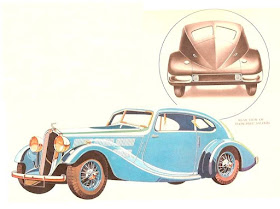Often, front ends of cars were little changed, the somewhat faux-streamlining taking the form of rounded fenders and curved aft rooflines. This was the case in England, where in the mid-1930s a number of low-production coupés were given this treatment. This body style was known there as "Airline."
Airline styling is the subject of the book "Art Deco and British Car Design: The Airline Cars of the 1930s" by Barrie Down, Amazon link here. I strongly object to the use of the term "Art Deco" in the title, as that usually refers to ornamentation and decoration rather than form. (Yes, I know there are small sculptures of gazelles and even female dancers that might be so-classified. But I draw the line at car shapes.) However, aside from grinding my teeth every time "Art Deco" was used, I found the book both interesting and useful.
One example was the Triumph Gloria "Flow-free" that was first shown at the 1934 London Motor Show. The designer was Walter Belgrove. Due to a Lufwaffe bombing raid on Coventry, company records dealing with the Flow-free were destroyed. Barrie Down notes that about 22 might have been built, and none are known to survive.
What exists today is a car based on a 1938 Triumph Vitesse chassis. It seems that 50 Flow-free bodies were contracted, and one not used by Triumph was put on a 1931 4.5 lire Bentley. This required some re-shaping. In 1994 the Bentley's owner decided to restore it to its original condition, so the Flow-free body became surplus. Restorer Rob Green brought the body, restored it to the original shape and put it on the Vitesse, and that is what is shown below. I have no information on original sources for the colored photos.
Two views of the Free-flow displayed in 1934. It has a trim, nicely proportioned appearance. But the most interesting details are obscured.
I might be mistaken, but his seems to be from a brochure or other promotional item. The centerline crease running down the top to the faux- boat tail is revealed.
Here is the "restored" Triumph Flow-free.
Side view. The rear fender profile and its wheel opening do not relate well towards the upper-left as seen here. But there's no such problem on the 1934 show car.
This is the interesting part of the design with its boat-tail shaping and central crease. The backlight windows are large for the mid-30s, and are deeply inset because their glass is flat and the roof is curved. Note the cut-line for the trunk lid. Well done, Walter Belgrove!






No comments:
Post a Comment